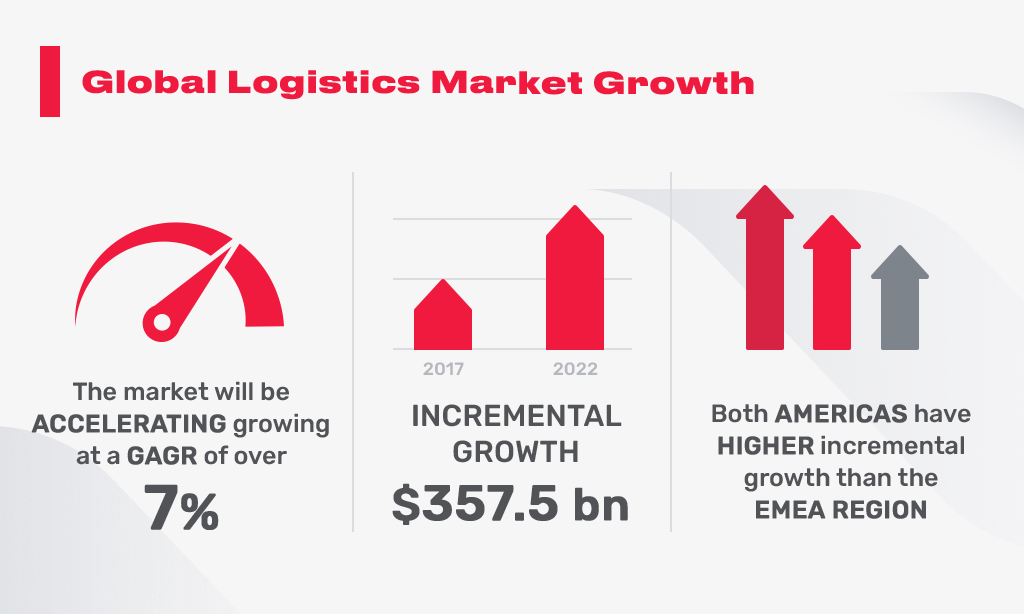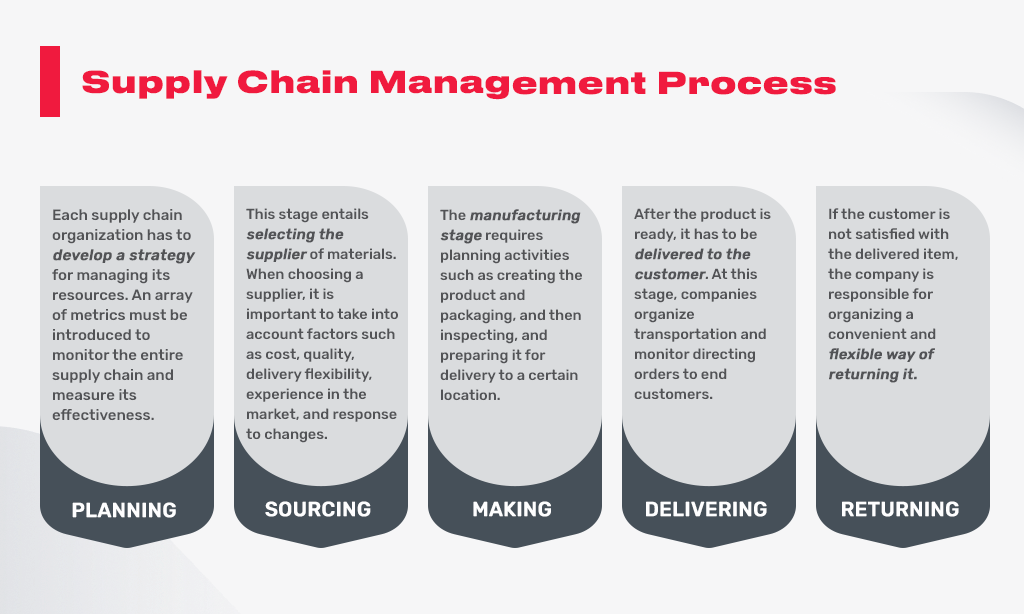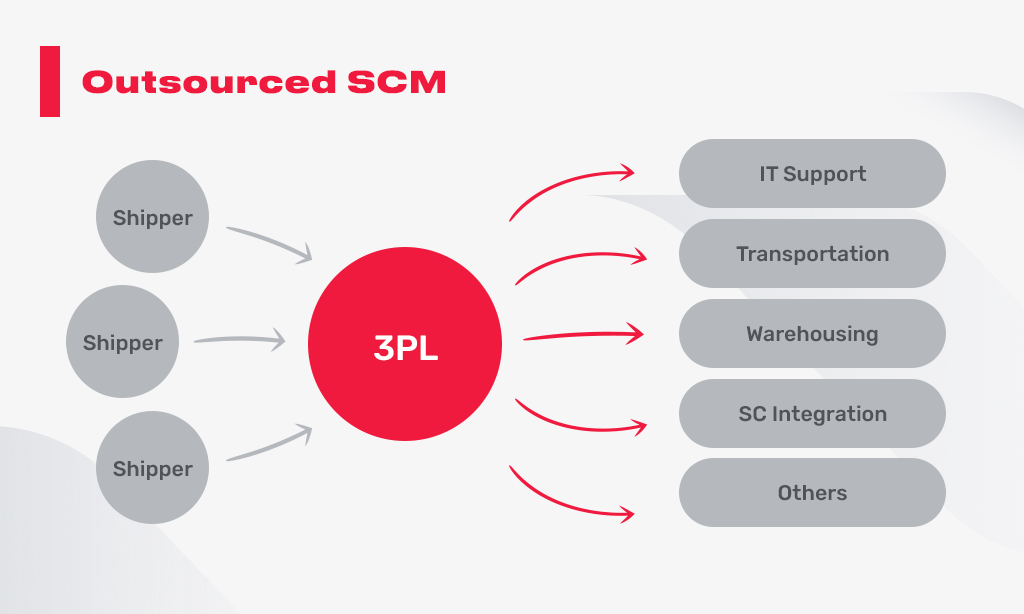How to Connect Shippers and Transportation Providers in Third-Party Logistics (3PL)
Over the last few years, the logistics industry has seen significant evolution. According to TechNavio, the global logistics market share will increase to $357.5 billion by 2022 with a compound annual growth rate (CAGR) of 7%.
Factors such as the increased popularity of online shopping, more high-speed Internet connections, and the faster adoption of mobile services can explain this prediction.

As a result of this industry growth, the demand for improved transportation services has also risen. To streamline the overall supply chain management (SCM) and make it cost-effective, many small and mid-size e-commerce businesses have already started partnering with third-party logistics (3PL) services.
Thus, this blog post will cover the following topics:
- key peculiarities and benefits of 3PL services
- major connectivity types between shippers and 3PL transportation providers
- benefits of API-led connectivity over other types
What is 3PL?
SCM is a complicated process that includes such components as planning, sourcing, making, delivering, and returning. All these stages must be streamlined and controlled.

To organize and maintain all the SCM stages in-house, the company spends huge financial resources. This process is time-consuming and the probability of making a mistake in, let’s say, packaging or delivering is high.
To streamline the overall process and minimize any risks, companies partner with 3PL logistics businesses. 3PL entails outsourcing some part of the responsibilities to intermediary businesses.
To clarify the difference between an in-house SCM and one operated by a 3PL company, see the pictures below.
In-house operations:

Outsourced operations:

Types of 3PL Services
The services provided by 3PL companies include shipment, transportation of orders, warehousing, and distribution. Let’s investigate each of them in detail.
Warehousing and Distribution Services Provided by 3PLs
Warehouse and goods distribution management is a typical service that 3PL logistics offers. These services include storing and shipping goods and managing their return back to the warehouse.
Multiple 3PL providers of such services have started applying smart software to improve the entire supply chain. For example, 3PL Central has recently released Small Parcel Shipping Suite that includes three solutions: SmartScan, SmartPack, SmartParcel.
If integrated into your warehouse management system, the suite helps optimize the workflow by eliminating paperwork and automating operations.
SmartPack Solution Interface

SmartParcel Solution Interface

Take into account the following factors before choosing a 3PL company:
- Network. Having a huge database of customers means that a wide network of warehouses is needed to guarantee in-time local delivery. So, make sure the 3PL company you choose has access to global warehouses.
- Pricing model. Prior to signing a contract with a 3PL logistics provider, carefully investigate the pricing model. Make sure it is transparent and understand possible pricing changes in case your company grows or the market fluctuates.
- Insurance. Negotiate the insurance policy before partnering with any 3PL business. Decide what items have to be insured while shipping them to a final location (for example, you need to insure only the products with the price higher than $200).
The leading American 3PL logistics company partnered with Innovecs to develop a warehouse management system to accommodate any type of business requirements and enable businesses to make rapid decisions with confidence.
The team developed a fully functioning 3PL system that can be implemented at multiple client’s locations. It provides capabilities such as business intelligence, radio frequency identification tracking, direct store delivery, and labor management system.
Transportation Services Provided by 3PLs
There are also 3PL companies that offer transportation services to facilitate the movement of goods between locations. These services include transportation of the inventory within your warehouse and transportation of packages between your warehouse and the retailer.
When choosing the transportation provider, consider the following factors:
- origin and destination locations
- transportation timeframes
- methods of products’ shipment
- level of 3PL services
- export/import tax rates and duties if transporting globally
- pricing model and the possibility of getting discounts
Among leading international 3PL providers of classic transportation services are UPS, FedEx, DHL, Dynamic 3PL, and others. Delivery within 24 hours can be performed by local 3PL companies such as UberRush or Postmates. To connect sellers and buyers, Grand Junction, Freightos, or Flexport marketplaces are used.
Shipping Services Provided by 3PLs
When providing product shipment services, 3PL providers take on the responsibility to control the entire shipping process. To automate processes, they apply specific software such as transportation management systems (TMS) or integrated freight management systems (FMS).

Such providers collect and analyze all freight data and build detailed matrix reports to improve visibility and enhance control on shipment results.
Examples of such providers include companies such as Worldwide Express, Red Stag Fulfillment, GlobalTranz, AFS Logistics, and Cerasis.
Types of Connectivity Between Shippers and 3PL Companies
To ensure an error-free connection and the secure exchange of information between your organization and the 3PL provider, you have to apply some technological tools. As of today, there are three methods of creating such a connection:
- Electronic Data Interchange (EDI)
- Electronic Air Waybill (e-AWB)
- Application Programming Interface (API)
Let’s explore the key peculiarities of each in detail.
EDI-based 3PL Systems
Regardless of its restrictions, the most popular type of data exchange is EDI. This technology originated in the post-war period as a means of communication between supply chain parties.
EDI replaces paper and enables standardized electronic message exchange in 3PL. Many retail giants such as Walmart use EDI as a secure means of computer-to-computer data exchange.
Manual data exchange with the help of fax and mail

Data Exchange through EDI

Initially, this technology was considered a valuable asset in 3PL logistics since it reduced human intervention and eliminated paperwork. However, today EDI has begun losing its value.
By employing a number of various standards that, in turn, have their own sub-standards, EDI significantly complicates the data exchange process. EDI transfers encrypted messages that can’t be easily read. These messages are segmented and contain unrecognized coded values. Moreover, the number of codes is finite, which can limit communication between your company and a 3PL provider.
To apply EDI in your operations, the meaning of all values have to be learned. Also, you will be required to teach your internal IT team members to take the right actions after processing transmitted messages. It requires many financial investments and takes a lot of time, which is precious in SCM.
e-AWB-based 3PL Systems
Another 3PL connectivity method is Electronic Air Waybill (e-AWB), which was founded by the International Air Transport Association (IATA) in 2010 as a separate type of information exchange aimed at airlines.
e-AWB is defined as an irreplaceable document for air cargo that stipulates the contractual agreement between the “shipper” and the “carrier.” The purpose of this method is to eliminate the usage of paper documents exchanged between the shipper and the 3PL service provider.

It is possible to integrate e-AWB only if you already have an established EDI communication channel with a shipper that supports the same documents’ format. Implementation includes four key steps:
- First, shippers have to sign an agreement with IATA. For this, fill in and submit the form, e-sign the received agreement, and wait until IATA sends you a copy of the e-signed agreement.
- Second, buy Cargo-XML, which is a toolkit that allows for the automation of electronic transactions of messages. It enables sending/receiving messages with the status of the freight, archiving messages, and printing them on demand.
- Third, before transferring messages, make sure the data is of good quality. Invalid data, delayed messages, and syntax errors are the most frequent issues that may occur. To perform data QA, you can try the AutoCheck tool provided by IATA.
- Finally, activate the agreement and confirm that all parties are ready to start e-AWB data exchange.

In 2013, Hellmann Worldwide Logistics, the global freight forwarding organization, implemented Electronic Air Waybill. The company switched entirely to digital data exchange with Lufthansa Cargo and now forwards more than 1000 e-AWB documents each month. They state that this method has saved them lots of money and boosted the efficiency of data exchange in 3PL.
API-based 3PL Systems
The last connectivity type between shippers and 3PL transportation providers is through an API, which is defined as a method of software applications integration that ensures their seamless communication through the Internet.
In simple words, an API connects two applications by plugging one app into the services and data of another app.

For example, if you use the eBay application on your mobile device, note that you use an API. Each time you open the application, it forwards a request to the API through the Internet. Then, the server searches for the information you have requested and forwards it back to your smartphone. This information gets converted into a visual form so that you can read and understand it. Simply put, an API functions as a translator between various platforms, servers, or user interfaces.
REST (Representational State Transfer) and SOAP (Simple Object Access Protocol) are two well-recognized APIs. REST is more relevant to SCM because it is compatible with all data formats, including XML, HTML, TXT, and JSON. With the help of the REST API, multiple processes can be run through a single communication channel. In turn, SOAP applies separate channels for various communication threads.
Advantages of API in 3PL
Using an API has the biggest impact on the 3PL logistics industry as compared to EDI and e-AWB. It serves as an effective augmentation of the EDI technology and enables real-time information exchange. In general, it provides three major advantages for shippers and 3PL providers:
- possibility to exchange messages between parties in milliseconds, which cuts delivery times and increases customer satisfaction
- instant access to real-time data across the entire cycle of the supply chain, which boosts transparency and visibility
- no need for human intervention to translate messages sent by API, which significantly reduces costs and saves time
How to Integrate API in 3PL
Innovecs is hugely experienced in integrating APIs into the SCM flow, which includes multiple third-party providers. In the video, you can see the comprehensive integration model.
Note that this model is simplified and displays only a one-way data integration. However, the flow demonstrated in the video can be applied both ways: shipper → provider or provider → shipper.
Best 3PL API Providers
Among all API providers, 4 companies have gained the most recognition in the 3PL logistics market. They are FedEx, UPS, Amazon, and DB Schenker. If you do not have resources for the development of custom integration model, you can try any of the following in your operations:
- FedEx’s API enables the integration of your SCM applications with FedEx services to generate labels, track orders, facilitate returns, and build shipping reports.
- UPS’s API instruments provide a set of options such as barcodes reading, monitoring of the entire shipment process, generating cost-efficient transportation routes, etc.
- Amazon’s API services are mostly aimed at automating payment processes across the supply chain.
- DB Schenker’s API allows for the tracking of items across the shipment process, including routes, schedules, product details, etc.
Bottom Line: Best 3PL Logistics Connectivity Method
The 3PL logistics market is steadily growing, and it is critical for both shippers and 3PL service providers to ensure a convenient means of data exchange. Among all possible methods (EDI, e-AWB, and API), using an API is the best option for effective SCM. It guarantees the instant exchange of messages and real-time access to data.
If you are interested in implementing API into your operations, just contact Innovecs via sales@innovecs.com and we will do our best to facilitate your 3PL project.